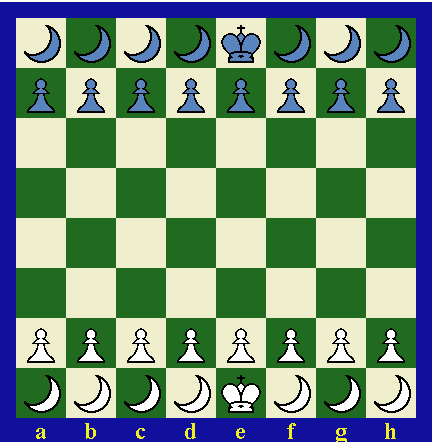Bario
Origin
The chess variant I want to speak about was called Bario by its inventor. I think the name is derived from a Greek word which means difficult or heavy because the intention of the author was to create a game which would be the most difficult game on earth, even more difficult than the Asian board game of Go. Beside this fact one should be able to play this game on a normal chessboard with the traditional set of chess pieces.
I read about this chess variant in the German chess periodical "Rochade" (I think it was in 1998 or 1999). Unfortunately I lost the magazine so I have to write everything down from memory. But this is not that difficult because the basic concept of Bario is very simple and at the same time really brilliant I think.
I don´t know the name of the inventor because the author of the article was not the original inventor as far as I remember.
(Editor's note: I was not able to find another reference to this game, nor to the periodical, "Rochade". If anyone has information regarding the periodical, original publication, original author, or the inventor, please post a comment to this page.)
Rules
The Bario initial position:

(Editor's note: the above diagram was created by the editor using Game Courier. The letter designations used by the author should refer to the Pawn and King images. The question marks should refer to the crescents.)
This diagram represents a traditional chess board. P=pawn, K=king
The question marks (crescents -- Ed.) represent the basic idea of Bario, namely undefined pieces.
Explanation: In Bario your pieces (Q, R, B, Kn) remain in an undefined state like a quantum in quantum physics which is observed as a wave or a particle only after (or while) observation.
The question marks stand for a potential piece which takes a definite shape (Q, R, B, Kn) only when you decide to move it. Before that the potential piece has the potential to become everything (except a king or a pawn of course). So with every move of a potential piece you decide what kind of piece from a standard chess set it should become. Of course you can only use ONE standard chess set, so you cannot have more than one queen, two rooks, two bishops or two knights after you have defined all your potential pieces.
After you have defined a piece it remains manifested as this kind of piece till the end of the cycle.
The cycle is over after the last undefined piece has been defined by a player and then simultaneously all the pieces fall back into their undefined initial state and a new cycle begins.
Standard chess rules are valid.
The rules of castling remain the same although with logical extensions with regard to the potentiality of pieces.
I don`t remember these extensions exactly now but I remember that they can be easily derived from the rules so that everything is consistent. I am sure that this will not be a problem for the chess variants community after the basic rules are "open sourced" and understood J . This applies of course also for the rest of all possible cases which are not explained here explicitly.
I also hope that someone is able to program a Zillions rules file for this chess variant.
Feel free to edit my contribution and enjoy Bario!
Kind regards
Alex